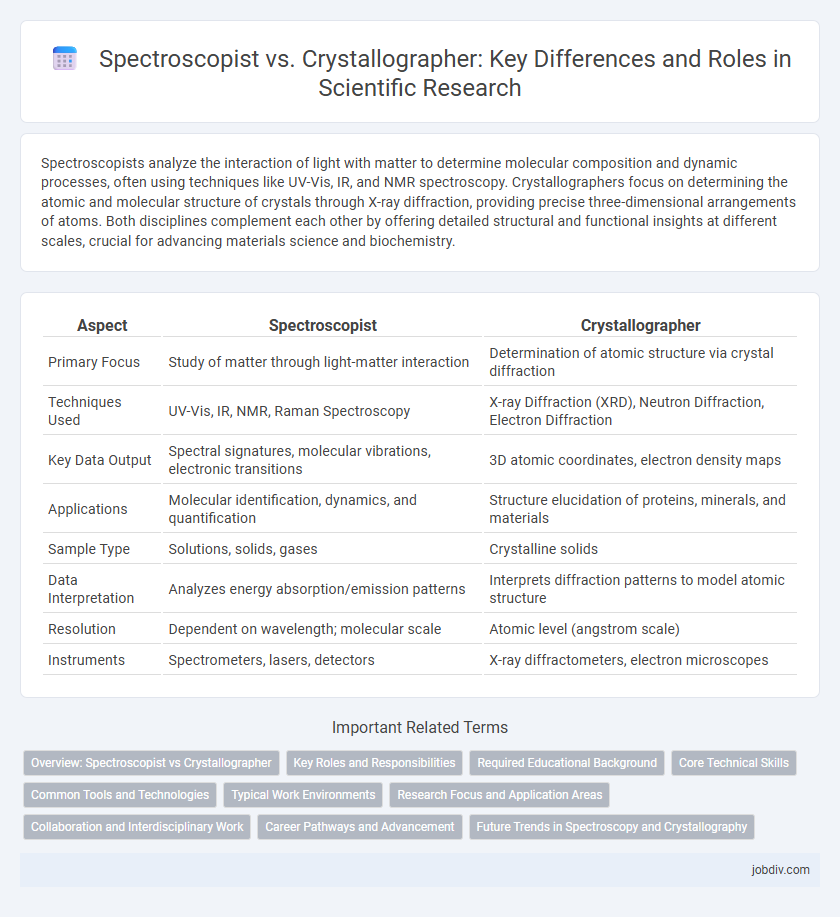Spectroscopists analyze the interaction of light with matter to determine molecular composition and dynamic processes, often using techniques like UV-Vis, IR, and NMR spectroscopy. Crystallographers focus on determining the atomic and molecular structure of crystals through X-ray diffraction, providing precise three-dimensional arrangements of atoms. Both disciplines complement each other by offering detailed structural and functional insights at different scales, crucial for advancing materials science and biochemistry.
Table of Comparison
| Aspect | Spectroscopist | Crystallographer |
|---|---|---|
| Primary Focus | Study of matter through light-matter interaction | Determination of atomic structure via crystal diffraction |
| Techniques Used | UV-Vis, IR, NMR, Raman Spectroscopy | X-ray Diffraction (XRD), Neutron Diffraction, Electron Diffraction |
| Key Data Output | Spectral signatures, molecular vibrations, electronic transitions | 3D atomic coordinates, electron density maps |
| Applications | Molecular identification, dynamics, and quantification | Structure elucidation of proteins, minerals, and materials |
| Sample Type | Solutions, solids, gases | Crystalline solids |
| Data Interpretation | Analyzes energy absorption/emission patterns | Interprets diffraction patterns to model atomic structure |
| Resolution | Dependent on wavelength; molecular scale | Atomic level (angstrom scale) |
| Instruments | Spectrometers, lasers, detectors | X-ray diffractometers, electron microscopes |
Overview: Spectroscopist vs Crystallographer
Spectroscopists analyze the interaction between matter and electromagnetic radiation to determine molecular structure, composition, and dynamics, employing techniques such as NMR, IR, UV-Vis, and Raman spectroscopy. Crystallographers specialize in elucidating the atomic and molecular structure of crystals through X-ray diffraction, electron diffraction, and neutron diffraction methods. While both disciplines aim to reveal structural information, spectroscopists focus on spectral data related to energy transitions, whereas crystallographers provide precise spatial arrangements within crystalline solids.
Key Roles and Responsibilities
Spectroscopists specialize in analyzing the interaction of light with matter to determine molecular composition, structure, and dynamics using techniques such as UV-Vis, IR, and NMR spectroscopy. Crystallographers focus on elucidating atomic and molecular structures through X-ray diffraction, electron diffraction, or neutron diffraction, providing precise 3D models of crystalline materials. While spectroscopists emphasize molecular behavior and chemical environments, crystallographers reveal spatial atomic arrangements critical for understanding material properties and biological functions.
Required Educational Background
Spectroscopists typically require a strong background in physics or chemistry, often holding a bachelor's or master's degree in these fields with specialized training in spectroscopic techniques and instrumentation. Crystallographers generally need advanced education in materials science, chemistry, or physics, commonly obtaining a master's or doctoral degree focused on X-ray diffraction and crystallographic analysis. Both professions emphasize rigorous coursework in analytical methods, quantum mechanics, and data interpretation to accurately characterize molecular and atomic structures.
Core Technical Skills
Spectroscopists excel in analyzing the interaction of electromagnetic radiation with matter using techniques like NMR, UV-Vis, and IR spectroscopy to determine molecular structure and dynamics. Crystallographers specialize in X-ray diffraction methods to elucidate the atomic and molecular structure of crystals, requiring expertise in crystallography software and data interpretation. Both fields demand strong skills in data analysis, laser technology, and precision instrumentation, but spectroscopists prioritize spectral data acquisition while crystallographers focus on diffraction pattern analysis.
Common Tools and Technologies
Spectroscopists commonly utilize UV-Vis spectrometers, infrared (IR) spectrometers, and nuclear magnetic resonance (NMR) instruments to analyze molecular structures and compositions through light-matter interactions. Crystallographers primarily rely on X-ray diffractometers and electron microscopes to determine atomic arrangements and crystallographic data by examining diffraction patterns. Both fields integrate advanced software for data processing and structural modeling, enabling precise interpretation of experimental results.
Typical Work Environments
Spectroscopists primarily work in laboratories equipped with spectrometers and advanced analytical instruments to study the interaction of light with matter, often within chemical, pharmaceutical, or materials science industries. Crystallographers typically operate in research institutions, academic settings, or industrial labs with access to X-ray diffraction equipment and computational tools for analyzing crystal structures. Both specialists collaborate with interdisciplinary teams but differ in their environment's emphasis on either molecular spectra or atomic lattice investigations.
Research Focus and Application Areas
Spectroscopists primarily investigate the interaction between matter and electromagnetic radiation to analyze molecular structures and dynamics, playing a critical role in chemical identification and reaction monitoring. Crystallographers utilize X-ray diffraction and other crystallographic techniques to determine the atomic and molecular structure of crystals, essential for drug design, material science, and solid-state physics. Both disciplines contribute to structural analysis but differ in focus; spectroscopists emphasize spectral data interpretation while crystallographers focus on precise spatial arrangement within crystalline solids.
Collaboration and Interdisciplinary Work
Spectroscopists and crystallographers collaborate extensively to elucidate molecular structures and dynamics, combining spectral data with atomic-resolution crystallographic models. Integrating vibrational spectra and X-ray diffraction patterns enhances understanding of material properties and biological macromolecules. This interdisciplinary approach accelerates innovation in drug design, materials science, and structural biology through complementary analytical techniques.
Career Pathways and Advancement
Spectroscopists often begin their careers with degrees in chemistry, physics, or materials science, advancing through roles in analytical technique development and data interpretation across industries like pharmaceuticals and environmental science. Crystallographers typically pursue specialized education in crystallography or structural biology, progressing by mastering X-ray diffraction and electron microscopy to elucidate molecular structures in academia, biotechnology, or materials engineering. Career advancement for spectroscopists and crystallographers depends heavily on expertise in instrumentation, research publications, and contributions to complex problem-solving in their respective fields.
Future Trends in Spectroscopy and Crystallography
Emerging technologies in spectroscopy, such as ultrafast laser systems and quantum-enhanced sensors, are driving unprecedented precision in molecular analysis, enabling spectroscopists to capture dynamic chemical processes in real time. Crystallographers are increasingly adopting cryo-electron microscopy and advanced computational modeling to resolve complex biomolecular structures at near-atomic resolution, transforming drug discovery and materials science. Integration of artificial intelligence and machine learning algorithms is accelerating data interpretation in both spectroscopy and crystallography, fostering innovations in high-throughput experimentation and personalized scientific insights.
Spectroscopist vs Crystallographer Infographic

 jobdiv.com
jobdiv.com